ASUS G73SW + SNB: Third Time’s the Charm?
by Jarred Walton on March 4, 2011 12:00 AM ESTSystem Temperatures
We’ll start with our usual shot from HWMonitor. I should note that I’ve received a couple emails over the past few months questioning the stability of the G73 notebooks—there are some reports floating around the net stating that the series has overheating problems. While I’m sure individual notebooks have had problems, I’ve done my best to stress the G73SW as hard as I can, including running Furmark overnight, and a second overnight run of Furmark with the Cinebench SMP rendering looping in the background. There are no stability problems to report and the HWMonitor result below shows the internal temperature ranges for the various components.
The CPU cores and GPU all report a maximum internal temperature of 75C. That’s the same GPU temperature we recorded on the MSI GT680R, but the G73 is 8C cooler on the CPU temperature. So as far as temperatures go, I’m not at all concerned with the ability of the G73 chassis to deliver the goods. That doesn’t mean quality assurance (QA) is always perfect, or that there won’t be the occasional lemon in the batch, but stability, heat, noise, and performance were never an issue with this particular test sample. Ironically, we can’t say the same for the LCD (see below), but given the prerelease nature of our test unit (it was one of the CES 2011 show models, apparently), we’ll let that slide.
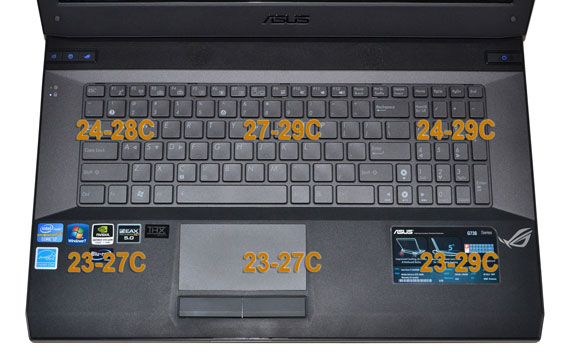
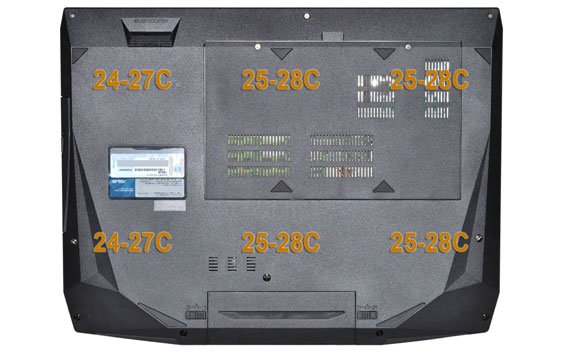
While the internal temperatures hit 75C, the surface temperatures on the G73SW are a lot lower. Unfortunately, my digital thermometer broke in the course of testing [that or the laptop was suddenly 95C or hotter on the surface], so I can’t provide load specifics. The above images show the idle surface temperatures; I’d estimate that the hot spots are around 5-10C higher under load, and in general the notebook runs reasonably cool considering the components. As stated in the intro, the large chassis does an excellent job at removing heat, and it does so without getting particularly loud. Idle noise levels measured 31.0dB at 18” and load noise (with Furmark and Cinebench SMP) topped out at 37.6dB. The noise also tends to be lower in pitch, so the G73 is very quiet compared to other gaming notebooks.
My guess is that the only thing between the G73 chassis and a GTX 485M or HD 6870M is the power brick and power circuitry, because the cooling setup looks like it still has plenty of headroom—especially if ASUS were to ramp up fan speeds and noise levels to compensate for the additional heat. The other thing keeping such high-end GPUs out of the G73 line is most likely price; ASUS has stated in the past that as soon as they start pushing beyond $1000, sales figures start to drop, and at $2000+ they plummet. That makes sense, though I’d still love to see some more competition for the high-end Clevo notebooks that can easily run into the $2500+ range.
What About the LCD?
As I mentioned above, there was an issue with our particular unit’s LCD. It’s not something that would affect benchmarks (outside of our LCD tests), but it was certainly distracting. At the heart of the problem are two things: first, the LCD would periodically flicker black. The only other time I’ve seen something like this was with a pre-release Dell Studio XPS 16. [Update: Several readers pointed out that this is an NVIDIA 266.58 driver bug specific to the G73SW.] The second problem with the panel is that there was a huge bright spot in the lower right that would show up once the panel got warm. You can see this as a yellow discoloration in the image below.
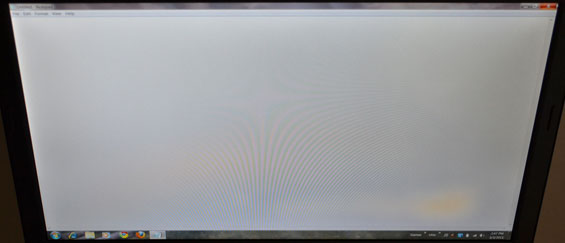
It appears to be a manufacturing glitch with the various layers of the LCD. If I purchased a notebook with this problem, you can bet I’d send it back. ASUS offered to ship me a replacement, but this problem isn’t something I’m overly concerned with. We’ve tested this same HannStar 171PUW-1 panel several times already, and the characteristics are always about the same. It’s got a great contrast ratio, a reasonable color gamut (particularly if all you’re concerned with is the sRGB color space), and it’s a nice 1080p display. That said, something really needs to be done about the relatively low maximum backlight intensity; it would be great to see 400-nit maximum white levels, with the ability to drop down to 50-75 nits minimum for dark LAN parties. Indoors, 155 nits is fine, but if the LCD is exposed to bright lights (i.e outdoors or in a harshly lit environment) you’ll have serious reflections. Actually, what would be ideal is to get matte LCDs with at least 750:1 contrast, but those seem to be a rare breed outside of MacBook Pros. Anyway, here are the LCD performance charts, with results slightly worse than the G73JW we tested previously.
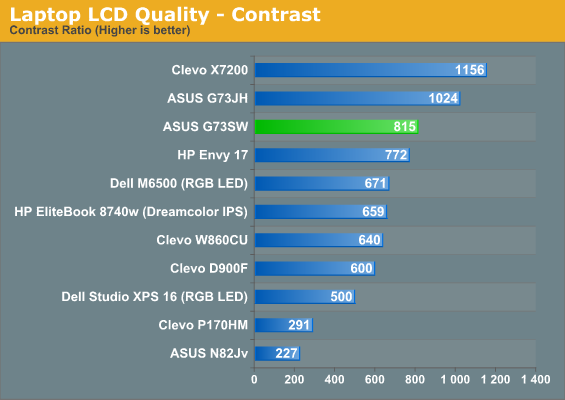

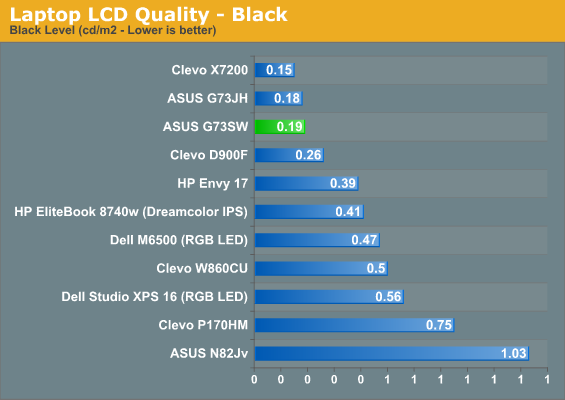
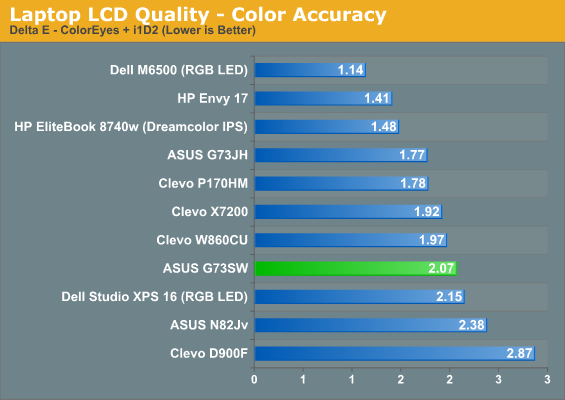
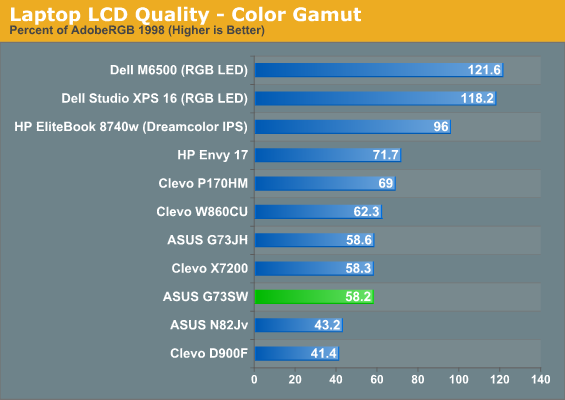
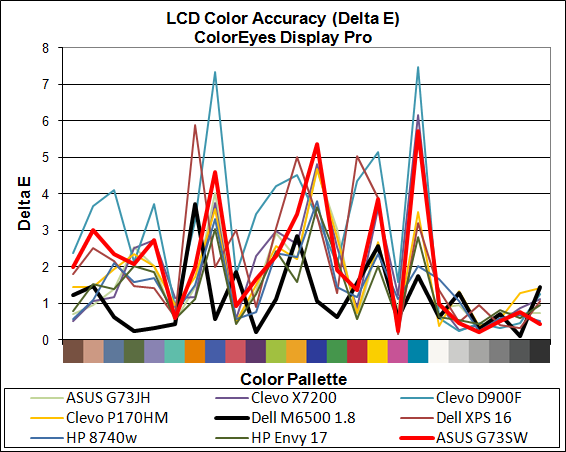
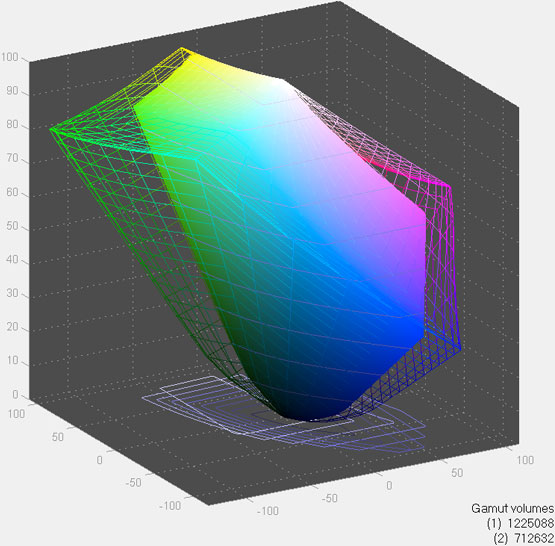


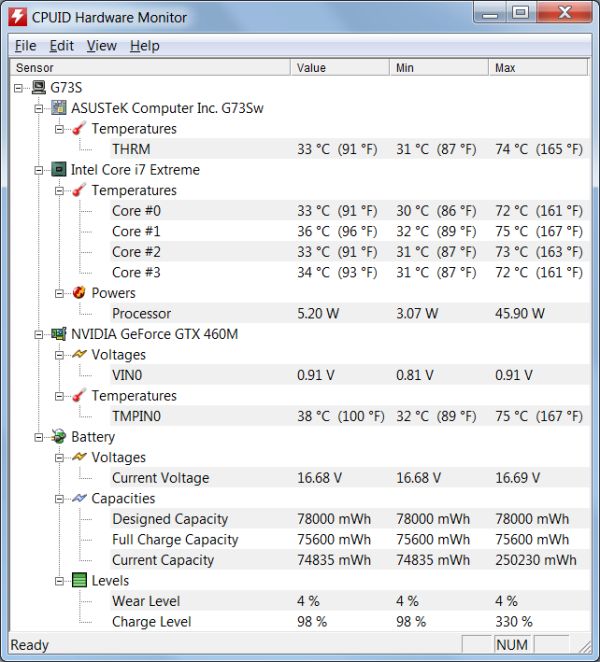














56 Comments
View All Comments
parthgh - Friday, March 4, 2011 - link
" So far, no one has been willing to try NVIDIA’s Optimus Technology with any mobile GPU faster than the GT 435M, although we hear there’s a GT 555M Optimus notebook coming some time in 1H’11."I guess XPS 17 has already launched and has Optimus enabled (apart from the 3D version).
Also the XPS 17 before SB revision had GT 445M with optimus enabled.
JarredWalton - Friday, March 4, 2011 - link
Still not faster than 460M... I didn't realize Dell upped the XPS 17 to the GT 555M, though. Interesting, and something I'll try to get them to send me now. Thank goodness they're now doing Optimus on all GPUs!Someone above asked about how they compare in performance, though. 460M has 192 cores at 675MHz with 2500MHz (effective) RAM. 555M has 144 cores at 590MHz with 1800MHz (effective) RAM. Note that 460M uses GDDR5 by default where the 555M goes with DDR3 by default. So the net result is 460M has 52.5% more computational power and 38.9% more memory bandwidth. I'd say GT 555M will be good for medium detail at 1080p, or high detail at 900p (give or take).
Drooosh - Saturday, March 5, 2011 - link
FYI - They won't allow you to get the good 1080P screen with Optimus. For some reason if you get the 1080P screen they force you to have it configured for 3D/120Hz which requires the 555M be enabled full time and thus no Optimus.I would bet that most customers are like me and would prefer Optimus over 3D. If they gave me FHD, 555M, and Optimus, I would by now.
Jarred, do you know of anyone that will have 555M or better switchable graphics, 1080P, and a backlit keyboard in a 15 or 17"? Lenovo or MSI may have thiese soon it appears?
JarredWalton - Saturday, March 5, 2011 - link
Right now, I'm not aware of anything like that. I don't know why Dell insists on doing weird things like killing Optimus support with certain upgrades. Perhaps Optimus doesn't work quite right with 3D at present? Heck, I'd just as soon skip all the 3D notebooks--the 120Hz panel is fine, but 3D just doesn't do anything for me.I've asked my NVIDIA contacts if there are any current/upcoming laptops with your above feature list. I've also asked them why no one appears to be willing to use Optimus with 460M or better. We'll see if they respond with any useful information. :-)
bennyg - Monday, March 7, 2011 - link
I heard rumours it's the way Optimus works sending the data from GPU to onboard gfx, the sheer amount of data pushed from high-end GPU to iGPU saturates that link, so midrange is OK but high-end suffers bigtime performance issuesIt does seem ridiculous that every SB laptop has the hardware to run ridiculous battery life (sans GPU of course) but not the drivers to allow it.
I don't care about Optimus and profiles. Give me a switch or a combo box and that will be better since I'll be in control not some numbskill algorithm. Just give me switching already!!!
strikeback03 - Friday, March 4, 2011 - link
In the Futuremark 3DMark Vantage Performance Score table on page 2 you have the wrong MSI laptop highlighted red.In the previous reviews I somehow missed how massive this laptop is, this time I noticed what a small portion of the chassis the 75WHr battery takes.
JarredWalton - Friday, March 4, 2011 - link
Thanks - the 3DMark Vantage chart is now correct. Also, I've added two more pictures to the gallery, this time with a tape measure in place. You can see the diagonal of the G73 chassis is about 20 inches (in a 17.3"-screen chassis...), and the Compal SNB unit we looked at in December also has a 17.3" LCD but the chassis is almost an inch smaller on the diagonal (and it's still got a lot of extra room for the large hinge). I'd like to see a 17.3" LCD in a chassis that's no more than 18.5", but I doubt that will happen.NaterGator - Friday, March 4, 2011 - link
As a G73SW owner I can absolutely 100% promise you this thing does not have an eSATA port anywhere to be found.Look over the unit they sent you again, but in the production unit I got from Amazon over a month ago there is most assuredly no eSATA. It is the only thing that frustrates me about this laptop, but the USB3.0 port makes up for it.
NaterGator - Friday, March 4, 2011 - link
Also, the screen flickering issue is a known bug with the nVidia drivers.Downgrade them to a 265 version and the flickering will stop.
JarredWalton - Friday, March 4, 2011 - link
I don't have that flickering problem on any other NVIDIA based laptops, though. Maybe it's localized to the G73SW for some reason? Anyway, you're correct about eSATA. Sorry for the error.